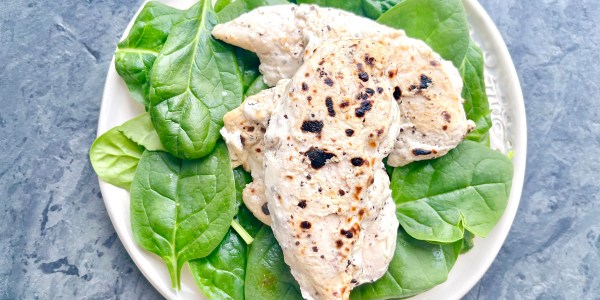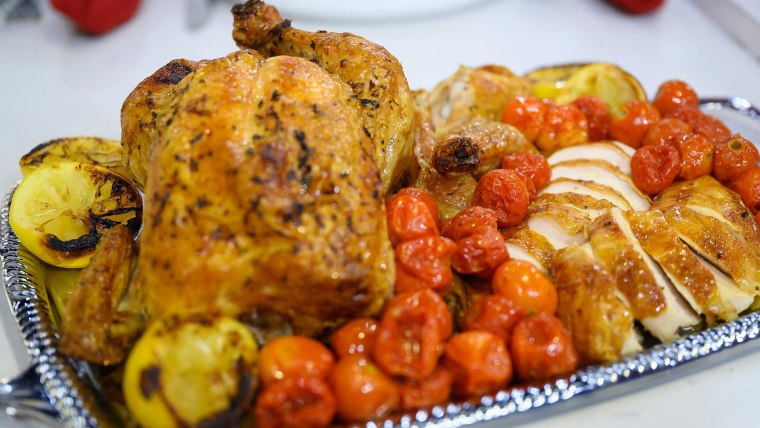No amount of pleading from chefs can shake people’s love for boneless, skinless chicken breasts. Yes, the bones add more flavor. Yes, skin too adds flavor (and texture). Yes, bone-in chicken is almost always cheaper. And yet, though I will remain on Team Chicken Thigh forever, the ease and speed of a blank canvas remains eternally appealing. Chicken breasts are healthy, quick and can take on any flavor. And with the right tips and techniques, you can avoid the rubbery, flavorless chicken breasts of all our collective nightmares.
The first step to solving a problem is always admitting that there is a problem, and so it goes with chicken breasts. There are a few reasons behind why chicken breasts can seem dry. When we make something boneless and skinless, we are removing all the fat and connective tissue that gives us moisture as we cook. That moisture gives us leeway — if we overcook the meat a little bit, that fat and tissue can keep some moisture present.
But there are solutions to improving your chicken breasts, none of which are particularly difficult or time-consuming.
How to buy better chicken breast
A lot of the problems with the chicken we eat has to do with incentives to raise chicken breeds that grow faster and to feed them as simply as possible. But that growth and food also contributes to their taste, and without sufficient time, they just won’t be as flavorful.
So, start by looking for slower-growing or heritage breeds — roaster chickens are older than broiler (although many breast-specific packages won’t include this). Brands, rather than generics, can also have better traceability to understand how the chickens were raised. And look for descriptions: Every buzzword doesn’t necessarily mean it is a better bird, but it does showcase more care — organic, free-range, non-GMO, antibiotic-free, Amish and kosher are all indications of an attempt at higher quality. Cost is certainly a factor for so many people, but sometimes these little shifts can be minimal on the wallet but profound on the flavor (and better for the chickens generally).
Get a meat thermometer
Nothing makes chicken drier than overcooking it. You can buy the best chicken and have the best brine or marinade, but if you cook it even a few minutes too long, you can’t do anything to fix it. Without the bones and skin adding in moisture, you have a small window of time to get it right.
But it is exceptionally easy to avoid this if you have a meat thermometer. And with some meat thermometers coming in cheaper than that family pack of chicken breasts, there is no reason not to get one. Check your meat when you are a few minutes shy of thinking you’re done to ensure you stay in the right zone.
Most sources online will say that chicken is safe to eat at 165 F. But that doesn’t mean you should pull your chicken when you see 165 — the temperature will rise at first as it rests. So I like to pull mine at 150 or 155 F. It will maintain temperature long enough to kill any harmful bacteria but will also ensure you don’t have a rubbery chicken breast.
Also, keep in mind the different sizes of your breasts. If one is thicker than the other, you might need to pull them out at different times. You can certainly pound down your breasts to make them even, but I think it’s often easier to just remove them a few minutes apart. Either way, if you have the meat thermometer, you’ll always have all the information you need.
How to brine or marinate chicken breast
To most people, a brine or marinade sounds like a time-consuming activity that negates the entire purpose of a quick and easy cut of meat. But even in just 15 minutes you can profoundly change your chicken breasts.
Brines and marinades help tenderize the meat by allowing more moisture into the protein. With that extra moisture, you lose less when you cook. The simplest method is a dry brine — unwrapping your breasts, salting them on both sides and letting them sit in the fridge for at least an hour.
But side by side, for breasts, I find a wet brine makes for a much more moist cut of meat. Dissolve 1/4 cup of salt in a cup of hot water and then dilute it with 3 cups of cold water. Add your breasts and let it sit for an hour — but even as little as 15 minutes can help.
The best tenderizer though, is a salted yogurt marinade. The salt has the same effect as in a regular brine, but the lactic acid in the yogurt further tenderizes it. A 15-minute marinade with 1 cup of yogurt and 1 teaspoon of salt makes for the most tender chicken breasts imaginable. It does add its own flavor, but it also allows for even more flavor to easily adhere to the chicken. Mix whichever flavors you want into your marinade and you don’t have to do anything else once it is done cooking.
How to cook chicken breast
The other benefit to chicken breasts is that they can cook in almost any scenario — on the stove, in the oven or popped onto a grill. But for every scenario there are a few tips that can improve your outcome. My favorite is under the broiler in the oven because you get the char and speed of the grill without the extra work. But all of these methods work great.
How to cook chicken breast in the oven
There are two ways to cook your breasts in the oven: bake or broil. I am partial to the broil because I think it creates great browning and retains moisture, but if you’re not comfortable with that, you can also bake. For both methods, you’ll want to put the breasts on a foil-lined sheet pan first.
To bake: Preheat your oven to 400 F. Put the breasts in the oven and cook for 30 to 40 minutes. To maintain extra moisture, I like to tent the foil halfway through to keep the breasts covered. Start checking the temperature after 25 to 30 minutes — the biggest mistake is overcooking, so check each breast since they are different sizes. Once you’ve reached 150 to 155 F, pull them out and let them rest.
To broil: Make sure a rack is close to the top, about 4 to 6 inches away from the heat source. Turn on the broiler (another advantage here is that you don’t have to preheat as long). Put the breasts in the oven and cook for 3 to 4 minutes, then turn over and cook for another 3 to 4 minutes.
How to cook chicken breast on the stove
Cooking breasts on the stove can feel easiest sometimes, especially when you are cooking for one or two people. The main key is retaining that moisture through ensuring the right temperature and covering.
Put a pan on high heat and add a bit of oil (unless the pan is nonstick). Put the breasts top-side down and cook for 3 to 4 minutes, or until they have browned. Turn the heat to medium-low, turn the breast over and then cover. Check in after 5 to 8 minutes, depending on the size of the breasts. Remove when they have reached an internal temperature of 150 to 155 F.
How to cook chicken breast on the grill
Nothing beats protein on a grill! Just make sure your grill is brushed with oil before putting any chicken on it.
To cook once your grill is going, start top-side down and cook for 3 to 4 minutes, then flip and put the cover on. Check in after 5 to 8 minutes, depending on the size of the breasts. Remove when they have reached an internal temperature of 150 to 155 F.
Want my favorite version? Try these marinated and broiled chicken breasts for the recipe that hands-down makes the most tender and flavorful version. But you can also use this recipe as a base — keep the yogurt and salt and then add whatever other spices and herbs you want to the mixture. Want something light and bright? Add a handful of chopped herbs instead of the spices. Want heat? Add hot sauce or sriracha. Want sweetness? Add some honey and balsamic. The choices are endless, but as long as you have salt and yogurt under the broiler, you’ll get the best texture around.

Ali Rosen


